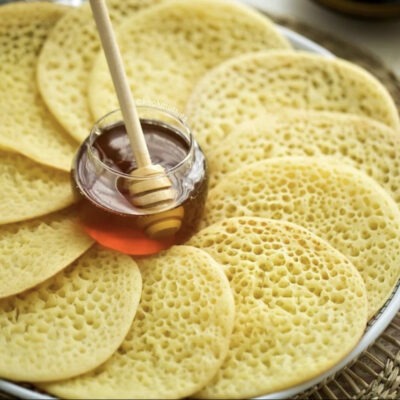Ingredients
- 250g of
Millet flour or brown teff flour
- 6g of
Baker's yeast
- 1 pinch of
Baking soda
- 500ml
Lukewarm water
- 1/2 teaspoon
Salt
Directions
Injera: the traditional Ethiopian bread
Injera bread is a typical bread of several African countries like Ethiopia or Eritrea. It is a round cake with a slightly sour taste and a spongy consistency. Injera bread, in addition to its delicious taste, is used to catch food in the hand. Traditionally served with Ethiopian dishes such as doro wat or tibs, injera is an essential accompaniment to Ethiopian cuisine.
It is traditionally made with millet flour or teff flour, which is a grain produced only in Africa. In this Injera recipe, we will use millet flour!
What is injera?
Injera is a flat, round pancake-like dish. It is made from a fermented dough of teff flour, which is a gluten-free grain that is commonly used in Ethiopian cooking. The dough is rolled out on a heated clay plate called a mitad and baked until it has risen slightly and holes form on the surface. The injera is then removed from the plate and stacked until it is ready to be served.
Accompanying the injera
Injera is traditionally served with a variety of Ethiopian dishes such as doro wat, a spicy chicken stew, or tibs, a spicy meat dish. It is also often served with spicy vegetables and lentils. Injera is used to dip sauces and main dishes, making it a friendly and delicious dish. Why not even accompany it with a good chicken yassa!
Injera is also a great side dish for people with celiac disease or other gluten sensitivities, as the teff flour is gluten free.
How to make these Ethiopian pancakes?
If you are interested in Ethiopian cuisine, you might be tempted to try making injera at home. The traditional injera recipe uses teff flour, a local grain that is very nutritious but can be difficult to find in some areas. However, it is possible to use other types of flour, such as wheat or sorghum flour, to make injera. Making injera can be time consuming and requires some technique, but with a little practice you should be able to succeed.
Ingredients needed
If you want to make injera at home, you will need the following ingredients: flour (teff, wheat or sorghum), water, yeast or sourdough, and salt. Some recipes also include optional ingredients, such as baking soda or fermented milk. The ratio of these ingredients varies from recipe to recipe, but in general, you should use about 3 parts water to 1 part flour.
Tips for making injera
Making injera may seem daunting to beginners, but there are a few tips that can help ensure the success of your dish. First, it is important to let the dough rest for several hours before baking to allow the yeast or leavening to ferment and develop the characteristic flavor of injera. Secondly, it is essential to heat the pan well before pouring the dough into it, in order to obtain a smooth and uniform surface. Finally, it is important not to overcook the injera so that it remains soft and slightly acidic.
The injera, a gluten-free bread
If you are gluten intolerant or follow a gluten free diet, you can still enjoy these Ethiopian pancakes by using alternative ingredients. Instead of teff flour, you can use rice flour, buckwheat flour, corn flour or quinoa flour to make the injera batter. You can also add potato starch or tapioca starch to give the dough a more elastic texture.
It’s your turn to make this recipe at home!
All in all, this is a traditional Ethiopian dish that is easy to prepare at home. It can be used as a base for a variety of side dishes, such as Ethiopian stews, grilled vegetables and salads. Although the use of teff flour is the most common, it is possible to substitute this flour with other types of gluten-free flour. It is important to remember that fermentation is a crucial step in achieving the characteristic soft and light texture of injera, and that it can take up to 3 days. Finally, feel free to experiment with toppings and spices to customize your dish to your taste.
Steps
1 Done | Preparation of Injera doughMix all the ingredients well except the salt in a large bowl. Add the salt, mix again then cover your mixture with cling film. |
2 Done | Cooking the Injera |
3 Done | Tasting of your homemade Injera!Your Injera patties are now ready! Taste them without moderation with your meats, fish and sauces of all kinds. Enjoy your lunch ! |











